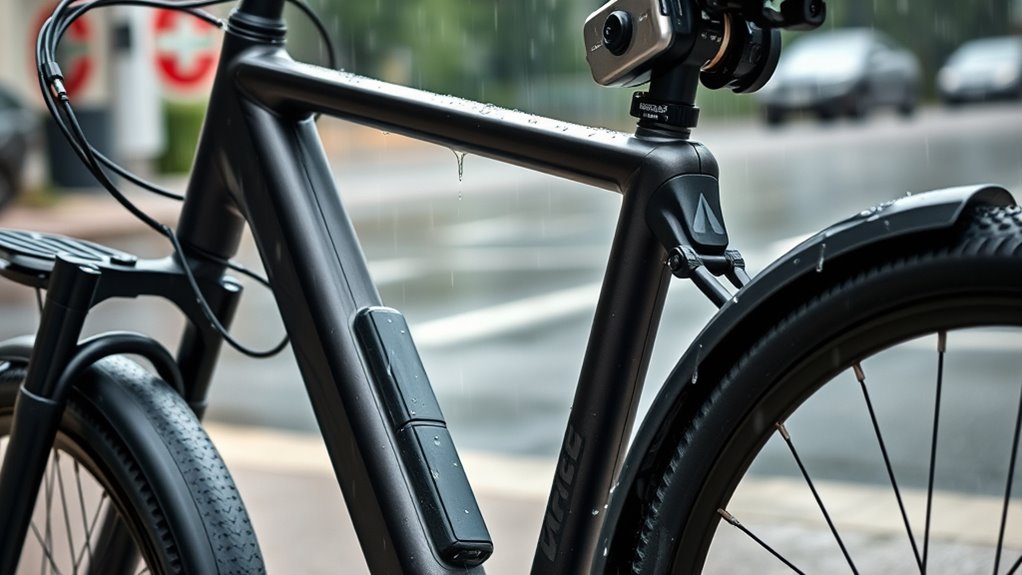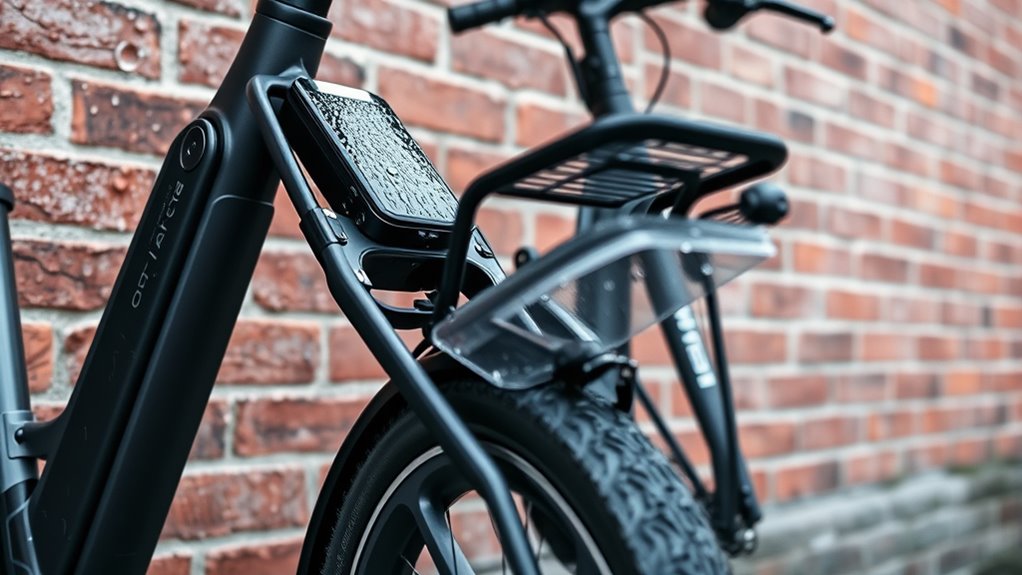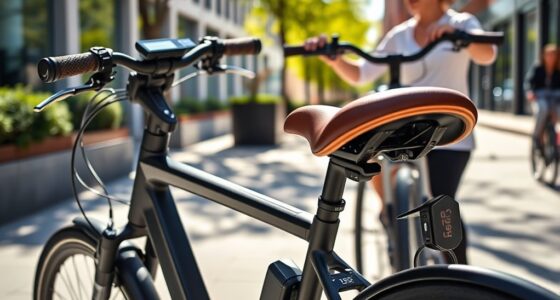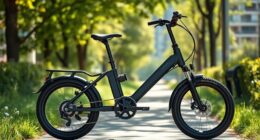To weatherproof your commuter e-bike, store it in a dry, sheltered spot and use waterproof covers or cases when outside. Protect the battery by removing and bringing it indoors during extreme weather, ensuring connections stay corrosion-free. Choose tires suited for all-weather conditions and check tire pressure regularly. Add fenders, lubricate the chain with weather-resistant lubricant, and inspect seals and electrical components. If you want to keep your e-bike reliable year-round, there’s more to take into account beyond these basics.
Key Takeaways
- Store the e-bike indoors or use weatherproof covers and battery cases to protect against rain, snow, and humidity.
- Regularly inspect and maintain tires with appropriate tread, pressure, and traction-enhancing features for all-weather riding.
- Use weather-resistant lubricants on chains and seals, and install fenders to prevent water and mud splashes.
- Remove the battery during extreme weather and ensure electrical components are sealed and moisture-proof.
- Keep the bike dry and sheltered when parked, and perform routine maintenance to prevent corrosion and damage.

Riding your commuter e-bike in all weather conditions is possible if you take the right steps to weatherproof it. One of the key areas to focus on is maintaining your battery properly. Exposure to rain and cold can reduce your battery’s lifespan and performance, so it’s essential to keep it protected. Always store your e-bike in a dry, sheltered place when not in use, especially during harsh weather. If you need to leave it outside, consider investing in a weatherproof battery cover or case. Regular battery maintenance is also crucial; check for corrosion on contacts and ensure the connections are secure. If your e-bike has a removable battery, take it inside during extreme weather to prevent moisture buildup and freezing temperatures, which can diminish capacity over time. Ensuring your battery is fully charged before inclement weather can also help maintain optimal performance and prevent issues caused by temperature fluctuations.
Protect your e-bike’s battery from rain and cold with proper storage and maintenance for optimal performance.
Tire selection plays a significant role in weatherproofing your e-bike. Choosing the right tires for wet or icy conditions ensures safer riding and better grip. Opt for tires with deeper treads designed for all-weather use, as they channel water away and reduce the risk of slipping. For winter riding, consider tires with a softer compound that provides better traction on ice and snow. Some riders find that adding puncture-resistant or wider tires improves stability and comfort in adverse conditions. Always check your tire pressure before rides; cold weather can cause pressure drops, leading to decreased traction and increased risk of flats. Maintaining proper tire pressure ensures optimal grip and handling, especially when roads are slick or covered with debris from storms.
Beyond battery and tires, weatherproofing your e-bike involves additional steps. Use fenders to keep water and mud from splashing onto sensitive components. Lubricate your chain regularly with a weather-resistant lubricant; this prevents rust and keeps your drivetrain running smoothly. Cover your bike with a waterproof tarp or use a dedicated storage solution to shield it from rain and snow when parked. Regularly inspect seals and gaskets around electrical components to ensure they’re intact and functioning properly. If your e-bike has electronic displays or lights, consider waterproof covers or sealants to prevent moisture ingress. Taking proactive measures such as using weatherproof lubricants can further protect vital parts from corrosion and damage, extending your e-bike’s lifespan.
Weatherproofing your commuter e-bike requires ongoing care and attention, but it’s well worth the effort. By focusing on battery maintenance, selecting the right tires, and protecting your bike’s other vital parts, you can confidently ride through rain, snow, and cold. These steps not only extend the lifespan of your e-bike but also ensure your safety and riding enjoyment in all conditions. With proper preparation, your e-bike becomes a reliable year-round commuting companion, regardless of the weather outside.
Frequently Asked Questions
Can Weatherproofing Affect My E-Bike’S Warranty?
Weatherproofing your e-bike can impact warranty implications, especially if you modify the bike outside manufacturer restrictions. Some manufacturers may void your warranty if you use non-approved accessories or DIY solutions, even if they improve weather resistance. Always check your warranty terms and manufacturer restrictions before making changes. Proper weatherproofing that follows guidelines generally shouldn’t affect your warranty, but unauthorized modifications might.
What’S the Best Way to Dry My E-Bike After Rain?
After rain exposure, you should use effective bike drying techniques to prevent damage. First, wipe down your e-bike with a dry microfiber cloth, focusing on the frame and components. Then, allow it to air dry in a shaded, well-ventilated area. Avoid using heat sources. Proper bike drying techniques help prevent moisture buildup, and practicing rain exposure prevention guarantees your e-bike stays in top shape longer.
Are There Specific Products Recommended for Waterproofing E-Bikes?
You might worry about damaging your e-bike with the wrong products, but sealant tapes and water-resistant sprays are safe bets. Use sealant tapes to cover exposed wiring and joints, creating a barrier against water. Apply water-resistant sprays to the frame and components for added protection. These products are easy to use, affordable, and effective, helping your e-bike withstand rainy days while keeping it in top shape.
How Often Should I Reapply Weatherproofing Treatments?
You should reapply weatherproofing treatments every 3 to 6 months, depending on product longevity and your riding conditions. Regular maintenance keeps your e-bike protected from moisture and dirt, so check the treatment’s durability and reapply as needed. If you ride often in rain or muddy areas, consider more frequent reapplications. Staying on a consistent maintenance schedule guarantees your e-bike remains weather-resistant and performs well over time.
Will Weatherproofing Reduce My E-Bike’S Overall Performance?
Weatherproofing your e-bike may cause a slight performance impact initially, but it’s usually minimal with proper application. It helps protect components from moisture and dirt, reducing maintenance considerations over time. If you apply treatments correctly, you shouldn’t notice a significant difference in ride quality or power. Regular maintenance and reapplication ensure your bike stays protected without compromising performance, making weatherproofing a smart choice for long-term reliability.
Conclusion
So, after all that weatherproofing, you might think your e-bike is invincible. But hey, even with the best protection, a surprise downpour or muddy trail can still catch you off guard. Irony’s sweet like that—no matter how prepared you are, Mother Nature always keeps a trick or two up her sleeve. Still, with these tips, you’re much better equipped. Just don’t forget to enjoy the ride, rain or shine!









